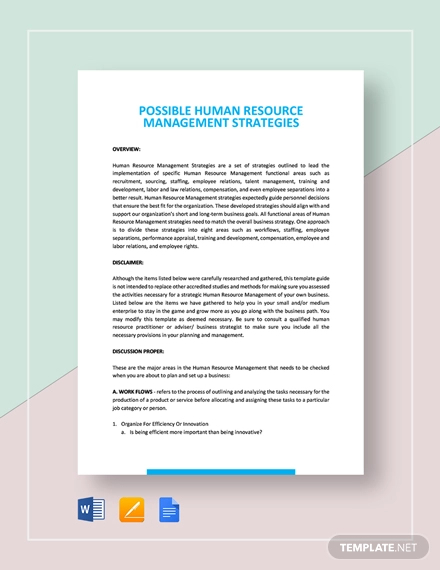Importance of Human Resource Management
Without a doubt, employees play a vital role in a company or business. Not only will a business be unable to run, but without them the business will go berserk and eventually burn itself to the ground. Even if you had people but are unable to get them in line, the same predicament would still be in store for your business. Herein lies the importance of managing a company’s most valuable asset—the people.
The human resource of every company is the people that make up the functioning organization. Without them, there can be no company. More than the products or services being offered, the people themselves are the company. One cannot simply exist without the other. As if bound by fate, each relies on the other for survival.
Possible Human Resource Management Strategies Template

Therefore, the proper management of each make up the lifeline of a business. People run the business; the business cannot run by itself. The very nature of a company is in its people, and giving direction to people is what human resource management is all about.

What Is Human Resource Management?
Human resource management in its simplest meaning is the management of human resources. It focuses on maximizing and optimizing the performance of employees to achieve the company’s goals or objectives. Human resource management ensures the smooth and proper implementation of policies and processes in the business.
To put it in another perspective, human resource management is there to keep the balance between employee needs and satisfaction in relation to the job and the company’s profitability and its capability to reach its goals. Human resource management includes:
- job analysis
- personnel needs assessment
- recruitment
- training and orientation
- wages and salaries
- benefits and incentives
- performance evaluation
- communications
- dispute resolution, among other things
It ensures proper relations in between employees, between employees and the organization, and the organization to the community. Human resource management is a growing field of expertise that is constantly widening its approach and scope in terms of striking that balance between an organization’s goals and individual personnel goals.
Scope of Human Resource Management
Human resource management is quite extensive and covers a very wide range of factors. It is quite a bemusing experience to narrow down everything, and therefore it should suffice to generally classify them under the following subheads.
Personnel Management
Also called “direct manpower management,” human resource management used to be comprised of only this classification. Functions include the most basic and elemental of human resource management, such as:
- staffing and hiring
- training and development
- induction and orientation
- transfer and promotion
- compensation and benefits
- layoff and termination
- employee efficiency
Personnel management aims to measure each employee’s growth, development, and efficiency, which is geared towards the overall development of the organization. Other functions included here would be evaluation factors such as performance appraisals, skills development, payment of salaries, incentives and allowances, and other policies and procedures.
Industrial or Labor Relations
Human resource management aims to improve relations between labor unions and the organization. It addresses grievances and effectively settles disputes to maintain order and harmony in the company. It mainly aims to safeguard the interests of the employee by understanding, maintaining, and promoting independence in relation to the interests of the employee and management.
Employee Welfare
This aspect mostly focuses on the conditions which affect an employee at work and other resources or amenities involved relating to safety, health, and medical services. It discusses:
- the elimination of hazards at work
- job safety/cleanliness
- adequate ventilation and lighting
- sanitation
- medical care
- health insurance benefits
- maternity benefits/family benefits
- unemployment benefits
- employee counseling
- supervision
- inter-employee communications
- education and training
Employee welfare aims to determine the needs of an employee, and answering those needs involving active participation from management and the employees.

What Are the Processes in Human Resource Management?
Human resource management relies on strategies in order to properly achieve the goals set by the company. In implementing these strategies, human resource management relies on the following processes:
Human Resource Planning
This process involves processes such as recruitment, evaluation, promotion, and termination.
- Recruitment – aims to attract the correct individuals that match the job description
- Selection – involves short-listing candidates in relation to qualifications, such as competency and potential for the job
- Hiring – deciding who the final candidate will be for the open job position
- Training and development – aims to improve an employee’s skills and potential for the job

Compensation and Benefits
There is that singularity we all share in terms of reasons for coming to work, and that is monetary compensation, i.e., to be paid. An important part of human resource management deals with the processes of deciding monetary values assigned for salaries or wages, incentives, and benefits.
Let’s be honest. Most if not all have money as prime motivator for doing any job. And being good at our jobs and displaying excellent performance additionally makes us seek for a salary raise or better wages and bonuses. Now, show me the money!
Performance Management
This process has the objective to develop, motivate, and reward employees. In the process, it also ensures that a company’s goals are efficiently achieved. This process includes any part of the business such as whole departments, to the product itself, service and any customer process which is aimed at adding value to such examples.
Employee Relations
Employee relations do not only include employee retention and the motivation for any employee to stay in an organization but also includes:
- labor law relations
- working environment
- employee safety and health
- conflict management
- quality of life at work
- worker compensation
- employee wellness and assistance
- counseling
Human resource management is as complicated as in what it deals with—human beings. Therefore, no single process ever is enough to sustain or appease issues. All processes are interlinked and must be effectively implemented side by side for human resource management to be considered effective at all.
There must exist a certain agreement in between the processes and the cohesiveness in the implementation of such processes. Often, money is not the only thing being considered by an employee in staying at a job or company but also the very environment and the factors existing in that environment that make or break an individual’s decision to stay (or go).
Importance of Human Resource Management
Behind every successful organization is a good team of working professionals dedicated to their craft and to the advancement of the company’s goals and interests.
Human resources play the role or recruiting and training professionals and eventually assigning them to proper roles where they can be of help to the business.
One can therefore conclude that there will be no building of a good team without having good human resource management. The benefits of having such human resource management include but is in no way limited to the following:
1. Recruitment and Training
One of the major responsibilities for a human resource team is recruitment and training. This is where it all begins. Plans and strategies are drawn for the purpose of hiring the right people for the job. The human resource team…
- tailors each requirement to meet the needs of a specific job function.
- further specifies the responsibilities and the scope attached to the job function.
- prepares the contract of the employee.
- facilitates the training of the employee in accordance to the job requirements formulated.
- provides further training for existing employees, thereby increasing their skills and usefulness to the company.
2. Preserving a Good Working Environment
It is without question that a safe, clean, and healthy environment helps increase the overall feeling of wellness in an employee. Being comfortable and enjoying the atmosphere in a workplace helps bring out the best performance of an employee and contributes in how an employee feels working in the company which translates further to job satisfaction.
3. Performance Evaluation and Improvement
Human resource management aims to have employees reach their full potential in relation to work and provides healthy suggestions and feedback for improvement. Employees are given information from time to time regarding their performance and further defines the roles they are given which helps them focus on what needs to be improved or missing. This helps the employees have a concrete or better understanding of their roles and responsibilities in the job and how they can further improve on it.
Performance evaluation provides a company measure of performance for an employee. Without having some sort of scale to measure an employee’s performance, some may end up in jobs where their skills just are not a good match for. This also helps the company identify employees who are under performing and just plainly wasting the company’s money.
4. Dispute Management
It is but inevitable for disputes to arise in any organization. Human resource, after all, is a diverse resource that is filled with many individuals coming from different cultures and different backgrounds. No two humans are ever alike, and clashing personalities would always be at the forefront of employee relations.
Human resource management effectively acts as mediator and consultant in these circumstances and helps sort out the issues involved between parties. Hearing out grievances from each side helps them come up with viable solutions which when taken in a timely manner prevents issues from blowing up out of proportions.
5. Public Relations Development
The image of a business is as important to maintaining the standards of work a company has. Human resource management helps in raising awareness of the public to your company or line of business. Human resource teams actively participate in communities like organizing seminars, business meetings, or other official get-togethers in order to develop public relations with other businesses or institutions and to the general consumer public. Human resources management further develops seminars and business meetings to provide exposure for the company to the public, thereby improving or increasing public image.
Businesses want to be recognized as the preferred employer. Having a good public image encourages the best minds to come looking for a job at your place. Human resource management likewise aims to have a balance in recruiting the most suitable applicants and retaining talented employees.
6. Budget Control and Cost Savings
With the development of ways to cut down workforce-management costs, HR management prevents excessive spending by, for example, negotiating for better rates in terms of benefits in healthcare coverage and other. HR management bases wage-setting by studying the labor market, employment trends, and based on job functions.
Additionally, new hires and replacement workers cost more due to costs involved during training and ramp-up time, especially for small business. Having an efficient recruitment and selection process, human resources can then maximize expenses in connection to advertising job postings, new-hire training, and benefit plans for new hire employees.
Downfalls Caused by Improper Human Resource Management

While most companies work toward avoiding mistakes caused by hiring the wrong person for the job, the following are the common things that result from not being able to manage human resource effectively.
1. High Turnover Rate
For human resources, high turnover rate is the ratio of employees leaving the company versus the rate at which they are being hired (or the number of employees at the start of the evaluation period). High turnover rate usually equates to turnover costs which include the following costs.
- The cost to hire a replacement – includes recruitment costs such as ads and headhunters, interview costs, travel costs, credential testing, pre-employment screening tests, signing bonuses and relocation bonuses.
- The cost to train a new hire – training costs include training materials, time converted for training, benefits, administrative processing such as opening of accounts, emails, and enrollment to payroll.
- The cost for that new hire to reach the same productivity level as the one who left – which mostly involves hours of production or office time.
- Opportunity costs – costs involved in not getting a sale or project because of your lack of employees to handle it (while these are probably consequential and hard to measure, these opportunities are real and otherwise wasted).
2. Complacent Employees
Employees who seem to not be doing their best when it comes to their work must have reasons. For the most part, the reason would be demotivation. Most employees would feel demotivated having to cover for leaving employees and waiting for the replacement to take the additional load they are doing.
Another reason may be for policies not being followed to the letter. Strict implementation of the rules should accompany proper procedure and disciplinary action in fairness to the violation made.

3. Discrimination Cases
Discrimination cases happen when there is a lapse on the side of management to clearly define the boundaries for discrimination. By clearly stating it in your personnel policy and having an employee understand the policy clearly prevents such cases from arising out of the workplace.
4. Being Fined for Occupational Hazards and Unsafe Practices
Penalties and fines make up for a substantial cost and a plain slap-in-the-face bad rep. Human resource management aims to maintain a company’s good image, and having bad reputation on these matters leaves a somewhat bad taste in managers’ mouths.
5. Employee Discontent
Happens when employees feel they are being undervalued and underpaid in the company. This is a clear indication of human resource management failure that aims to promote satisfaction from both employee and employer. Mostly this results from poor salary-rate analysis and review and simply not paying attention to employee satisfaction surveys and interviews.
Courses of action to take to solve this issue:
- The root cause of the problem should be immediately identified and resolved.
- Proper expectations should be set to help employees clearly understand what to expect in terms of pay, benefits, and promotions.
- Another way to go about it is approaching the situation in a personal manner and treating employees as part of one big business family. This way you can both be honest and straight to the point in discussing what you want and what the other needs.
6. Decrease in Production Efficiency
Most notably happens when new processes are introduced to the working environment. All goes back to the training and re-training of employees to handle the new processes. Human resource management should be able to track and identify the measure of skill and effectiveness for each employee and identify which ones need further training or re-training.
7. Unfair Labor Practices
As human resource management is directed at hiring only the best candidates and keeping skilled employees, enforcement of standards in terms of labor laws and codes should be strictly followed and not compromised. Doing so would considerably boost employee performance since labor practices are only geared toward the welfare of employees.

While there exists no sure silver bullet to avoid mistakes in managing human resources, one easy way would be to look at your current employee satisfaction.
This can easily be done through various methods available, such as surveys and exit interviews. Remember that retaining employees who already know the ins and outs of your business is far better and way cheaper than going through the process of hiring new employees and crossing fingers on the hope that they do well.


